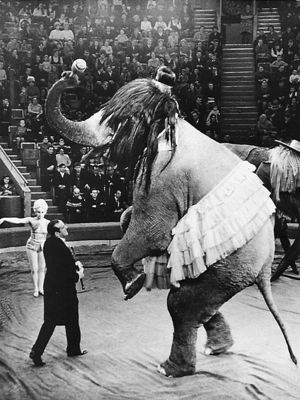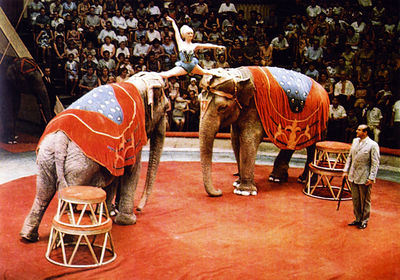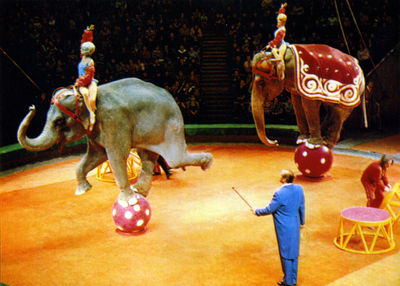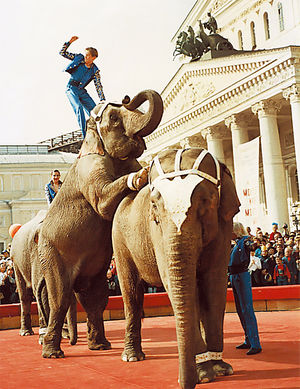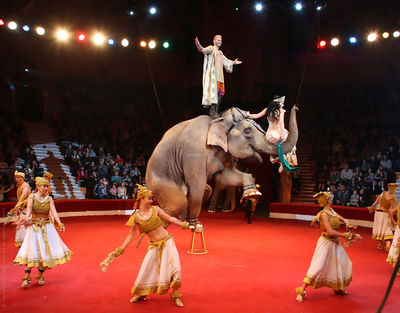The Kornilov Dynasty
From Circopedia
Elephant Trainers
By Dominique Jando
There never have been many elephant acts in the Soviet and Russian circus. Several members of the Durov family have included one pachyderm or two in their animal presentations and a small number of animal trainers, such as Boris Fedotov, Sarvat Begbudi and Msistlav Zapashny have trained elephants. The Kornilov Dynasty, however, is the exception that confirms the rule: Since 1929, they have not only been the great Russian elephant-training specialists, but they also have been among the world’s very best—and the productions of their magnificent acts remain unequaled.
Aleksandr Kornilov
Born November 22, 1903 in Russia, Aleksandr Nikolaievich Kornilov (1903-1977), the founder of the Dynasty, began his professional life as a sailor. At the end of the 1920s, he landed in Samara, the great port city on the Volga river, where he discovered the traveling menagerie of Ivan Lazarevich Filatov (1873-1956)—the father of the legendary Russian bear trainer Valentin Filatov, and scion of an old family of itinerant animal trainers.
This unforeseen encounter changed Kornilov’s life: Although he was indeed fascinated by the Filatov Menagerie exhibitions, he was even more attracted to Masha, the pretty young girl who handled the box office. Masha (Maria Ivanovna Filatova, 1904-1975) was Ivan Lazarevich’s daughter: They quickly fell in love, and Aleksandr decided to stay on dry land and follow Masha, whom he eventually married.Now part of the family, Aleksandr had to bring his contribution to his father-in-law’s business. Working as a simple cage and stable boy, he did his apprenticeship on the job. After having acquired enough experience caring for the menagerie’s animals, he finally made his public debut as a trainer in 1929 with a group that included brown bears, polar bears and lions. He presented also the menagerie’s single elephant in a sketch titled The Elephant at the Restaurant.
Elephant training appealed to Aleksandr, and Ivan Filatov eventually trusted his pachyderm to him. Later, three additional elephants joined his original animal when Kornilov became part of the central system of Soviet circuses (G.O.M.E.Ts., which later became SoyuzGosTsirk); it allowed him to expand his act without having to bear personally the financial burden. (Ivan Filatov, for his part, was asked by the government to organize the zoological park system of the U.S.S.R.)
At a time when Russian elephant acts included only one or two animals, Kornilov’s four elephants looked like a herd! This effect was amplified in 1943 when he created his first "attraction(Russian) A circus act that can occupy up to the entire second half of a circus performance.," Elephants and Dancers, with a group of fourteen dancers whose soloist was the young and talented Nina Suprun—the future Nina Kornilova.
Kornilov’s spectacular attraction(Russian) A circus act that can occupy up to the entire second half of a circus performance. quickly became a star act of the Soviet circus, which was then entering its golden age; in 1944, it won the first prize of the famous All-Union Circus Competition, the most prestigious talent competition of the Soviet circus world—which was then closed to the outside world. Yet, Aleksandr Kornilov didn’t limit his training talents to the presentation of elephants: He added Siberian camels, ponies, horses and bears to his attraction(Russian) A circus act that can occupy up to the entire second half of a circus performance., and even boas that embraced dancers in the ballet.
His acute sense of the spectacular, which he shared with Valentin Filatov (and may have owed to Ivan Filatov, their teacher), made him a valuable constituent of the Soviet Circus, and one of his most successful act producers. In 1969, after a career that spanned forty years, Aleksandr Nikolaievich Kornilov was elevated to the title of People’s Artist of the Socialist Republic of Russia.
Anatoly and Nina Kornilov
Nina soon became a major participant in Aleksandr Kornilov’s act. Born Nina Andreevna Suprun on December 25, 1926 in Briansk (which, in Russian Orthodox Russia, is not Christmas Day) and trained in ballet since childhood, she had been a dancer in Rostov’s Operetta Theatre. The Soviet Circus central organization noticed her exceptional physical qualities and she was hired and given a complete circus training in order to be integrated in an act… that was never built! Since Kornilov was putting together his attraction(Russian) A circus act that can occupy up to the entire second half of a circus performance. at that time and needed a dancer with acrobatic talents, Nina was assigned in 1943 to the Kornilov ensemble, of which she became the soloist who worked directly with the elephants.
From her first marriage to K.K. Chevrotkin in 1946, she had a son, Yuriy Chevrotkin, who studied drama in St. Petersburg but returned to the circus, where he worked as a clownGeneric term for all clowns and augustes. '''Specific:''' In Europe, the elegant, whiteface character who plays the role of the straight man to the Auguste in a clown team.. Marriage and maternity kept Nina away from the ring for two years, but, in 1948, she was back in the Kornilov Troupe and would never leave it again. That year, Aleksandr Kornilov added to his act a teeterboardA seesaw made of wood, or fiberglass poles tied together, which is used to propel acrobats in the air. segment in which Nina, propelled by one elephant, turned a somersault and landed on the head of another elephant—a spectacular trickAny specific exercise in a circus act. that predated similar stunts by Gunther Gebel-Williams and the Richters.Nina began to familiarize herself with elephant training under Kornilov’s tutelage. Meanwhile, in 1950, she had a second son with K.K. Chevrotkin, Mikhail, who became an animal trainer known as Mikhail Chevrotkin-Kornilov. Yet, her marriage outside the circus was doomed to fail. She eventually divorced and, in 1958, re-married with Anatoly Aleksandrovich Kornilov (1924-1991), Aleksandr’s son, who was his father’s assistant in the act.
Born November 15, 1924, Anatoly made his debut in the ring at age seventeen, in 1941. During WWII, from 1943 to 1946, he served in the Soviet Army. (For his part, Aleksandr participated in the war effort by training service dogs.) Now married, Anatoly and Nina put together their own acts—a "Cossack act" on Siberian camels, and a comedy act in which bears impersonated firemen whose chief was Anatoly, while Nina was a nurse. These acts were part of the Kornilov ensemble, and the young couple continued to participate in the elephant act.
On May 19, 1961, Nina gave birth to their daughter, Taisiya Anatolievna Kornilova. In 1967, at age six, Taisiya (known as Taya) debuted in the ring with a newcomer in the act, a one-year-old young elephant named Maya. In the circus of Riga, where the Kornilovs were often working, a young spectator of Taya’s age, Aleksei Dementiev, saw her working with Maya and was fascinated. They would meet again later.
A New Era
Aleksandr Kornilov died on June 12, 1977 in Moscow. When he retired from performing in 1970, at age sixty-seven, Aleksandr had passed his attraction(Russian) A circus act that can occupy up to the entire second half of a circus performance. on to his son. By then, Nina was not just Aleksandr Kornilov’s daughter-in-law anymore: SoyuzGosTsirk had officially promoted her to the rank of Animal Trainer.
With the exception of young Maya, Kornilov’s elephants were old; they were retired and SoyuzGosTsirk gave the junior Kornilovs three new pachyderms. Anatoly and Nina decided to refresh the concept of Aleksandr’s old attraction(Russian) A circus act that can occupy up to the entire second half of a circus performance., and to do so, they conceived new training methods with specialized equipment—such as a suspended harness to help elephants learn to walk on their hind legs.
Beside the teeterboardA seesaw made of wood, or fiberglass poles tied together, which is used to propel acrobats in the air. segment, which was kept, the new act included an elephant walking on a rolling globe (without rails), an elephant balancing on a single front leg and another walking around the ring on her hind legs. There were also three St. Bernard dogs who rode the elephants (beside performing their own tricks) and a young lion—who quickly left the act when his size didn’t allow him to work cage-free anymore.Nina had conceived and directed the new attraction(Russian) A circus act that can occupy up to the entire second half of a circus performance. and gave it a completely new look. Presented for the first time in 1971, it was indeed worthy of the Kornilov tradition and met with considerable success. The attraction(Russian) A circus act that can occupy up to the entire second half of a circus performance. toured with an edition the "Moscow Circus" in Romania and Japan. Anatoly also created a new animal presentation that included zebras, ostriches, monkeys and snakes and was entrusted to Mikhail, Nina’s son.
A new elephant joined the family in 1982: Flora, a one-year-old African. Flora was an exceptional animal; she had a sweet nature and responded particularly well to training. It was also the first time that an African elephant was presented in a Russian ring. Nina remembered that working with Flora was a pleasure: one had just to show her the moves, and she replicated them without any problem. Flora became the star of the act; those who saw her crossing the ring on her hind legs while spinning hula-hoops on her trunk will never forget her!
In 1984, SoyuzGosTsirk gave Anatoly Kornilov the management of Riga’s circus (Latvia was then part of the Soviet Union). There, Nina devised a new attraction(Russian) A circus act that can occupy up to the entire second half of a circus performance., Elephants Around the Globe (with a choreography by Alla Dukhova and an original music by Maksim Prokovsky) and a production that became a Soviet circus milestone, Memories of Riga, which of course included their elephant act. Memories of Riga was presented abroad in 1986, at Budapest’s Fővárosi Nagycirkusz in Hungary.
That year, Nina and Anatoly were promoted to the rank of Honored Artists of the Socialist Republic of Russia. Anatoly and Nina retired in 1990 and the attraction(Russian) A circus act that can occupy up to the entire second half of a circus performance. passed into the hands of their daughter, Taisiya. Sadly, Anatoly didn’t have time to enjoy his retirement: He passed away the following year, on May 12, 1991, at age sixty-seven. As for Nina, she never left the circus and, to this day (2018), she continues to participate in the training of the Kornilovs’ elephants.
Taisiya & Aleksei Dementiev-Kornilov
Aged twenty-nine, Taisiya had become an accomplished artist; she was also a graduate of the GITIS institute (the Theater Institute of Moscow) with a degree in circus directing and choreography. During one of her parents’ several engagements at the circus of Riga, she and Aleksei Dementiev found themselves in the same school and the same class.
Born March 13, 1961 in Riga, Aleksei Stepanovich Dementiev (1961-2001) didn’t belong to a circus family: His father was the manager of a department store in the city. Aleksei and Taisiya became friends and, since they saw each other at regular intervals, their friendship evolved into a romantic relationship. They were eighteen when, in 1979, they decided to get married—but Aleksei was working at the time as a barman and Anatoly made it clear that he had not made his daughter the circus artist she was to see her marry a barman! Whoever would marry his daughter had to be a circus man.
To make matters worse, this latter idea was no more to the liking of Stepan Dementiev, Aleksei’s father, who didn’t want to see his heir work as a groom for a herd of elephants and assorted exotic animals. Yet, Aleksei was stubborn and, at 6:00 am on a morning that followed a heated confrontation between both family heads, he knocked at Anatoly’s door and signed then and there a job application for SoyuzGosTsirk. The lovers got married at last and Alksei began his apprenticeship on the job—as a groom first. Then Anatoly and Nina put together an equestrian quadrille in which they gave the young couple a part, along with Mikhail and Yuriy Chevrotkin.
On April 6, 1981, Taisiya gave birth to the couple’s first child, Andrei Dementiev-Kornilov. In 1983, two young elephants, Gerda and Pretty, who were both two years old, joined Maya and Flora in the group, replacing the two oldest elephants who went into retirement. These young elephants, along with Flora, were the first to be trained by Aleksei, who confirmed his talents as a first-rate trainer. In the process, Flora and Aleksei became exceptionally attached to each other.Aleksei had other skills, however: He had a keen sense of administrative management—which would help him after the fall of the Soviet Union. He was a good complement to Tayssia, who was free to focus on the artistic part of their work. As a performer, Aleksei had a strong charismatic presence in the ring: With his blond mane and his unbridled energy, he was the Russian equivalentz of the German-American star-trainer Gunther Gebel-Williams. Then, in 1991, one year after Aleksei and Taisiya had taken over the family act, the Soviet Union collapsed; the former Soviet, now Russian circus found itself in a precarious situation.
In order to survive and save their animals, the couple decided to create their own independent collective, which went on tour under the "Moscow Circus" banner in Europe, Asia, Australia, and in the United States—where they were presented in 1994 at New York’s Madison Square Garden by the Australian producer Michael Edgley. The previous year, Taisiya had given birth to their second child, Anastasia. In 2000, Aleksei and Taisiya were made Honored Artists of the Russian Federation. The following year, they received the Golden Star in a circus festival held at the Bolshoi Circus in Moscow.
But tragedy struck the Kornilov family at the dawn of the new century: On December 7, 2001, while they were touring in Belgium, Aleksei Dementiev was killed in a car accident; he was only forty years old and had fallen asleep at the wheel. His funeral, attended by all major players in the Russian circus community, was held in the ring of Circus Nikulin in Moscow. Courageously, Taisiya decided to continue their tour, and took over the act with her son Andrei, who had been performing in the ring since 1993. (He had debuted at Circus Nikulin at age twelve, playing a “volunteer” from the audience.) Andrei had been Flora’s main partner in the elephant act and had performed as a clown in the show.
The family and the Kornilov company were of course devastated by the loss of Aleksei, but Flora never recovered from the loss of her trainer and friend: She was constantly looking for his return, which never happened, and the sweet elephant became moody and aggressive. Finally, during a show in 2002, she attacked Taisiya, who owed her salvation to the swift intervention Andrei and her assistants, including Flora’s keeper who was seriously injured by Flora in the process. To everyone’s chagrin, Flora had to be taken off the act. She went into retirement at Moscow’s Zoopark, where she died in 2007.
Andrei and Anastasia Dementiev-Kornilov
Like Taisiya, his mother, Andrei Dementiev-Kornilov is a graduate of Moscow’s GITIS Institute, where he studied theater and movie directing. He had seen his future in these fields, but his father’s death changed his mind: He swore to continue his father’s work and transferred all his energy to serving the family act and the Kornilov tradition—of which he represents the fourth generation.
The various versions of the Kornilov’s attraction(Russian) A circus act that can occupy up to the entire second half of a circus performance., now presented by Andrei, who has inherited his father’s charismatic presence in the ring, are still directed by Taisiya while the elephants’ training is supervised by Nina. Andrei also runs with his mother the Kornilov Collective, which continues to tour Russia with considerable success (its latest production is titled Indi-Ra). Over the years, the Kornilov productions have become increasingly lavish, with sophisticated choreography and extravagant costumes—and it can be said that their elephants’ training has today no equal anywhere in the world. Andrei’s very presence has rejuvenated the act, giving it a freshness and an energy that are part of its success with a large audience of teenagers, to whom Andrei is like a rock star!Born November 13, 1993, Anastasia, Andrei’s sister, made her debut in the ring in 2011, after finishing her dance and acting training at the Art Theatre School in Moscow. At the time, the elephants were Chita, Gerda, Ranga and Pretty. Gerda and Ranga, who may be considered as "Russian elephants," have been hired several times to participate in Indian movies! They are still in the group (as of 2018), along with Presko and the young newcomer Margo, whose mischievous personality cannot impede a very promising talent.
In recent years, the Kornilovs have accumulated honors, the latest being a Special Golden Elephant and the Circopedia Award for Excellence in the Circus Arts, which they received in 2016 during the International Youth Festival of Circus Arts at Circus Nikulin in Moscow—in addition to a swarm of other prizes and trophies. They recognized Taisiya, Andrei and Anastasia’s masterpiece, The Mystery of the Giant Elephant, an extraordinary attraction(Russian) A circus act that can occupy up to the entire second half of a circus performance. presented on an Indian theme that is arguably the most accomplished elephant act in circus history—in the shadow of which Nina Kornilova remains a major contributor.
Beside Andrei and Anastasia, the fourth generation includes Olga Kornilova who has succeeded her father, Mikhail Chevrotkin-Kornilov, in the presentation of a group of exotic animals with her husband, Aleksandr Valiev, and the clowns Alex & Bella Sherr: Alex is Yuriy Chevrotkin’s son. The fifth generation is represented by the young Veronika Dementieva-Kornilova, the daughter of Andrei and his wife, Ekaterina, a former rhythmic gymnast that Andrei married on April 24, 2014.
See Also
- Video: Aleksandr Kornilov's elephant act at the Old Circus in Moscow (1944)
- Video: Aleksei Dementiev & Andrei Dementiev-Kornilov with Flora in Stockholm (1994)
- Video: Andrey Dementiev-Kornilov, elephant act, at the 5th Festival of Circus Arts in Moscow (2011)
- Video: Andrey Dementiev-Kornilov's Elephant Carnival at Circus Nikulin (2013)
- Video: The Circle, documentary, filmed at Circus Nikulin in Moscow (2016)
- Video: Olga Kornilova & Aleksandr Valiev, mixed animal act, at Circus Nikulin in Moscow (2016)
- Video: Anastasia & Andrey Dementiev-Kornilov's The Mustery of the Giant Elephants, at Circus Nikulin (2016)
- Video: Anastasia Dementieva-Kornilova, portrayed and interviewed by Vadim Vernik (in Russian) (2017)
